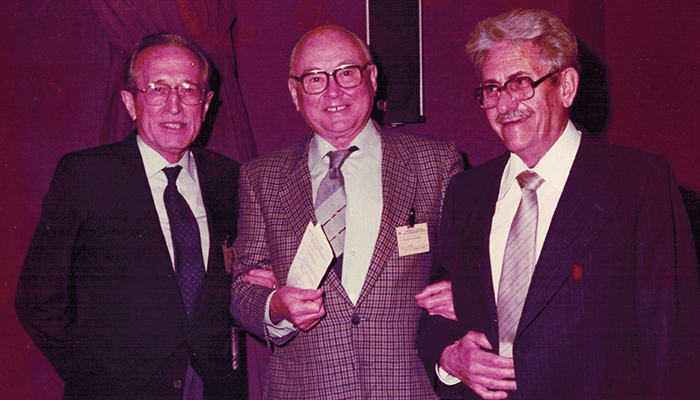
It is generally accepted that retinal light photocoagulation was first pioneered by Gerd Meyer-Schwickerath in the late 1940s (1). He presented three cases of retinal detachment successfully treated by retinal coagulation with sunlight during the lensectomy and vitrectomy meeting of the Deutsche Ophthalmologische Gesellschaft on September 28, 1949, in Hamburg, Germany. It seems that the “retinopathia solaris” gave him the idea of therapeutically focusing light on the retina to prevent rhegmatogenous retinal detachment.
But this assertion is not actually true! In fact, it was José Morón who authored the first known literature covering the practice of therapeutic photocoagulation of the retina, having used a similar technique in both rabbit and human eyes between 1945 and 1946 (2). These experiences appeared in his doctoral dissertation, defended in Madrid, Spain, on November 22, 1946 – almost three years before Meyer-Schwickerath’s pioneering presentation. Morón wrote, “Scars produced by sunlight are very variable in intensity, depending on the stational variations, amount of sunlight, moment of the day, atmospheric changes, ophthalmoscopy lens position, […] pupil size, refractive status of the patient, media transparency, retinal pigmentation, gaze direction” (3). In 1946, he performed the procedure using an intense white light in four patients with retinal detachment at his ophthalmological clinic in Seville. However, he did not publish his results until 1950, when he stated that, after reading Meyer-Schwickerath’s essays, he was motivated to report his experiences (4).
Perhaps because of the delay in releasing his results, the name Morón is, unfortunately, largely forgotten in the history of retinal photocoagulation. This is despite Meyer-Schwickerath’s naming Morón as one of the originators of photocoagulation (5,6) in his articles, indicating that he was likely inspired by the Spanish doctor’s works (7).
José Morón Salas was born in 1918 in Seville, Spain, where he spent the majority of his life. He finished his medical studies in 1941 and, in 1946, he defended his doctoral dissertation. In 1950, he spent a year in New York with Ramón Castroviejo, a famous ophthalmologist who significantly developed corneal transplant surgery.
Acknowledgement
I would like to thank Francisco J. Ascaso for his collaboration on showcasing José Morón’s ophthalmology contributions.
References
- G Meyer-Schwickerath, Ber Dtsch Ophthalmol Ges, 55, 256 (1949).
- D Peral, J Fernández-Sabugal, Asclepio, 49, 217 (1997). DOI: 10.3989/asclepio.1997.v49.i1.388.
- J Morón, Doctoral dissertation presented at Madrid Complutense University Library; November 22, 1946; Madrid, Spain.
- J Morón, Arch Soc Oftalmol Hisp Am, 10, 566 (1950).
- G Meyer-Schwickerath “Lichtkoagulation,” Stuttgart: Bucherei des Augenarztes, 33, 2 (1959).
- A Grzybowski, FJ Ascaso, Am J Ophthalmol, 159, 206 (2015). PMID: 25488644.
- R Castroviejo, Am J Ophthalmol, 63, 162 (1967). PMID: 6017673.
- FJ Ascaso, A Grzybowski, Acta Ophthalmol, 100, 234 (2022). PMID: 33629510.
- H Hamm, Dissertation presented at University of Hamburg; 1947; Hamburg, Germany.
- B Kirchhof B, et al., Graefe’s Arch Clin Exp Ophthalmol, 258, 1837 (2020). PMID: 32651627.
- G Meyer-Schwickerath, Graefes Archiv fur Ophthalmologie, 156, 2 (1954).
